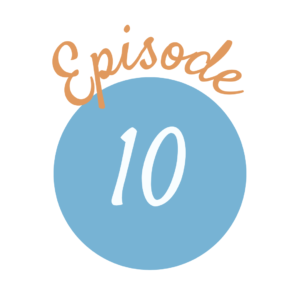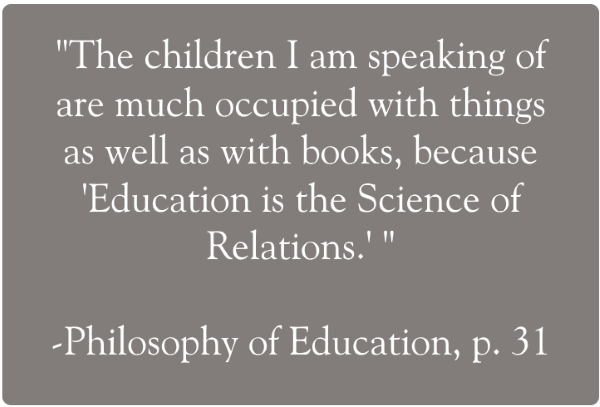
We think of school as paper, pencils, and books, but Mason’s delectable feast included innumerable other learning opportunities. We try to hit the highlights here of the vastly underrated world of things that can be considered critical to the well-rounded education.
Listen Now:


“The children I am speaking of are much occupied with things as well as with books, because ‘Education is the Science of Relations,’ is the principle which regulates their curriculum; that is, a child goes to school with many aptitudes which he should put into effect. So, he learns a good deal of science, because children have no difficulty in understanding principles, though technical details baffle them. He practises various handicrafts that he may know the feel of wood, clay, leather, and the joy of handling tools, that is, that he may establish a due relation with materials. But, always, it is the book, the knowledge, the clay, the bird or blossom, he thinks of, not his own place or his own progress.” (6/31)
“At the same time, here is the mother’s opportunity to train the seeing eye, the hearing ear, and to drop seeds of truth into the open soul of the child, which shall germinate, blossom, and bear fruit, without further help or knowledge of hers.” (1/44-45)
“At any rate he should go forth well furnished because imagination has the property of magical expansion, the more it holds the more it will hold.” (6/43)
“every hour spent in the open is a clear gain, tending to the increase of brain power and bodily vigour, and to the lengthening of life itself.” (1/42)
“The only sound method of teaching science is to afford a due combination of field or laboratory work, with such literary comments and amplifications as the subject affords.” (6/223)
“The work is arranged on the principles which have been set forth in this volume; a wide curriculum, a considerable number of books for each child in the several classes, and, besides, a couple of hours’ work daily, not with Books but with Things.” (3/271)

If you would like to study along with us, here are some passages from The Home Education Series and other Parent’s Review articles that would be helpful for this episode’s topic. You may also read the series online here, or get the free Kindle version from Fisher Academy.
School Education (Vol. 3), Chapter 21
Towards a Philosophy of Education (Vol. 6), Book I, Sections II and III

The Last Child in the Woods, Richard Louv
(Contains affiliate links)



I finally got a chance to listen! 🙂 A couple of things that jumped out to me were these:
1. those learning to read need physical action!!! This is so helpful and I think it is so true. I'm going to be working on this more with my children
2. That was so interesting what you said, Emily, about lines not being in nature, but edges…very helpful!
3. I love the idea of having a "museum of the mind"!!! How many times in my own life has a beautiful song, Scripture, or natural scene blessed me in a hard moment. What a wonderful thing to give our children ideas and images for life.
4. Thank you for the line "the idea needs to come first"!!! That is so worth chewing on…
5. I love how you emphasized balance! A needed reminder for me!
6. I was very interested in what you said about younger ages and needing to learn close observation more than just gadgets etc right now
Now for my questions! 🙂 😉 Some of these things you talked about fall kind of under "free play" – especially the outdoor running, jumping, etc…but other's need more direction like some of the handicrafts. How much oversight or direction do you give these and do you actually "schedule" these or do you just set a time and let what comes, come. ??? Hopefully, this makes sense??? Maybe because my children are younger, that is the answer to my own question. They just naturally need a little guidance. My oldest DOES do many things after picking up on an idea of her own. LEGOS and make believe with blocks etc etc…are those "things"??? That fall under "masterly inactivity"?… Anyway…I think I struggle with thinking I'm not doing ENOUGH in this "things" area, but I wonder if it's more just helping the younger ones with instruction to help them get started…I'm blathering here…you actually really encouraged me, because I think we are all too hard on ourselves about some of this and in reality as home educators, we are doing a lot of these things daily!
Thanks again and I'm giddy with excitement that you are going to go through each area and share your wisdom! 😀
Amy,
How wonderful that you are gleaning so much that is helpful to you. As to your questions, if I understand them, there is always a balance in helping and standing aside. In general, I think present day parents tend to hover excessively. When a craft is new, you should demonstrate and watch to ensure they understand, and perhaps encourage them to continue to finishing something, but their afternoons should be their own to play, work, read, explore. There's no hard and fast rule, but like all areas of freedom, age and experience mean less and less of Mom and more independence for them. I have read even recently how detrimental to future success it is for parents to do too much thinking for their children. When we get to handicrafts, I'm sure we will speak more specifically about guidance in that area.
– Liz
I absolutely love this podcast!! I am learning so much!! I plan to go back & listen to each one again & take notes so I can dig deeper. Thank you for this!!
And we are thankful you are learning and willing to learn more–because that's what it takes to be a CM mom.
-Liz
Thank you so much for outlining the place of these “things” in our childrens’ education. I have been using AO for three or so years now but am only now coming to understand how it all fits togther! So excited to implement these gems in the New Year..Ive been listening today from a very hot and dry Sunny day in Windhoek, Namibia, although we live in Durban, South Africa. Thank you so much!